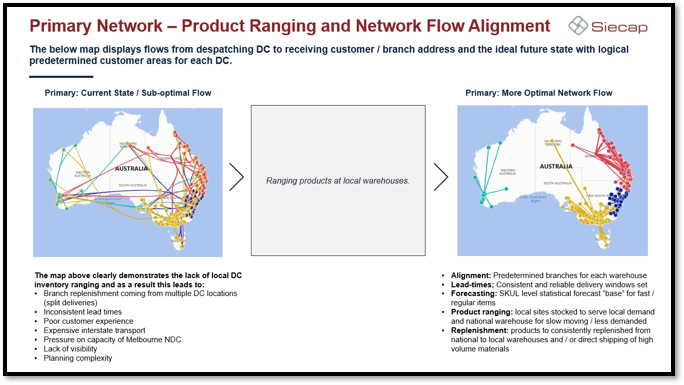Network Flow Scenario Analysis
“Am I holding the correct inventory at the correct locations?”
The answer could only be found by assessing a company’s network strategy.

An evaluation of the product holding strategy was required to identify how a change in state product ranging would impact customer service levels, transport, space, and activity costs.
SUMMARY
The client operated a network of over 600 branches supported by state-based warehouses supplied through one national distribution centre.
Having a centralised distribution model resulted in a high volume of inter-state LTL (less-than-truckload) deliveries and consequently a high unit transport cost.
This distribution model also impacted customer service due to increased lead times and split deliveries.
CHALLENGES
The client operated a network involving a wide product range using shared warehousing facilities.
As part of the review, products were assessed, not only on the total movements but also frequency of ordering, to make sure smaller market segments were correctly supported.
The main challenge being how to move away from a ‘one-size-fits-all’ distribution model, without significantly escalating costs.
 Could the previous policy of importing only full container loads (FCL), to the state warehouses be replaced by a hybrid model that incorporated interstate transfers for lower demand segments?
Could the previous policy of importing only full container loads (FCL), to the state warehouses be replaced by a hybrid model that incorporated interstate transfers for lower demand segments?

SOLUTION
Model build-up:
Upon the validation, a comprehensive model was built to simulate multiple product ranging models and multiple warehouse network options.
Recommendations and opportunities:
Two product range options were recommended, along with expected customer service level and cost savings.
The impact and local supply availability on the rest of the network was also assesses, if new warehouses were added in Northern QLD and South Australia.
RESULTS IDENTIFIED
- an optimum product ranging and warehouse network scenarios.
- warehouse space requirement to suit product ranging.
- improved customer service levels.
- cost saving opportunities
This supported the decision-making process with warehouse lease renewals.

CONCLUSION
Organisations develop their operational strategies to optimise cost and achieve desired customer service levels. However, due to highly volatile customer preferences, these operational strategies should be evaluated regularly to make sure they are still valid and support the customer service expectations and organisational financial objectives.
Siecap’s industry wide experience and modelling capabilities can assist your organisation in the process of evaluating your operational network and strategy and identify opportunities to re-align your network with organisational objectives.
